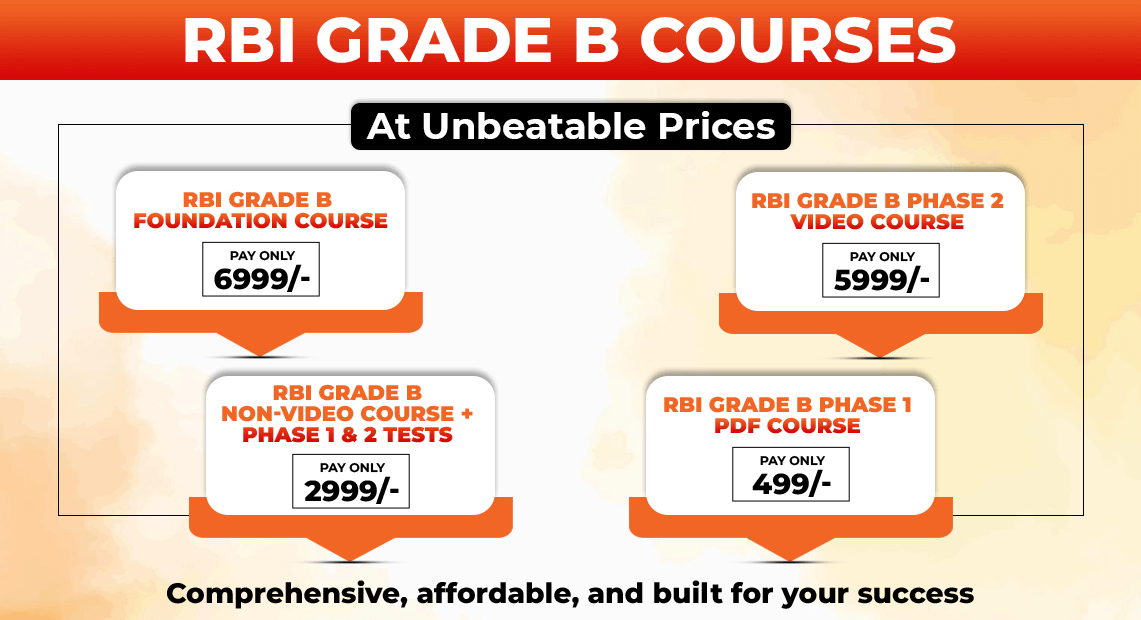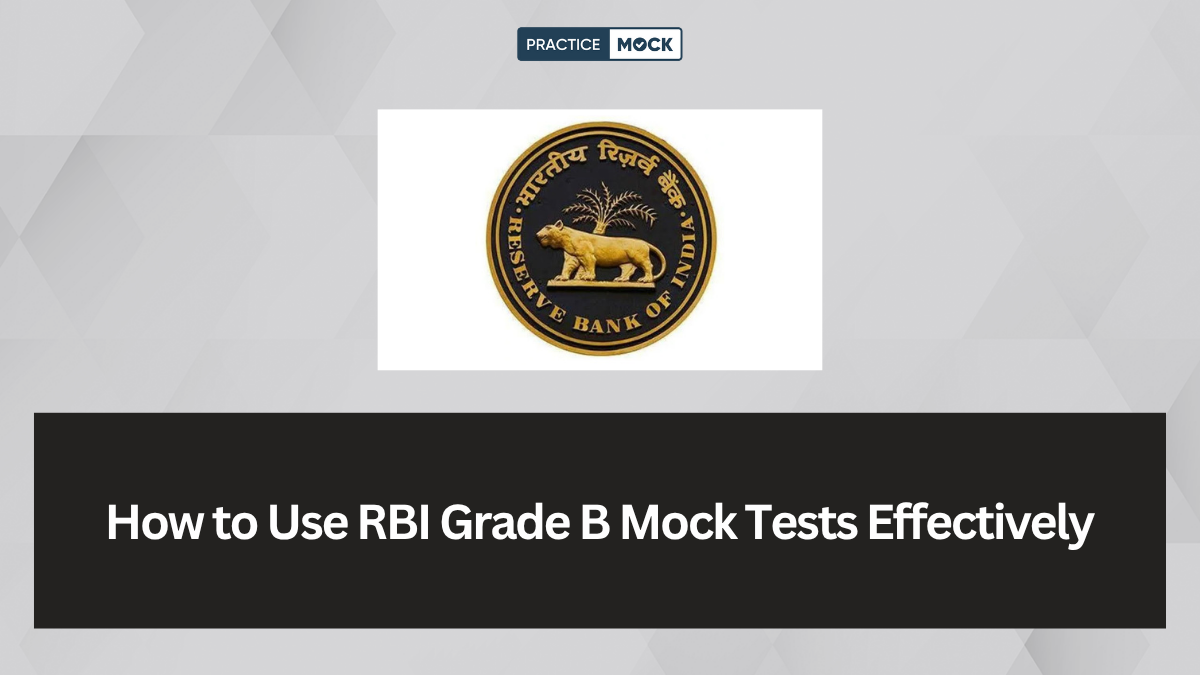Dear RBI Grade B aspirants, RBI Grade B Phase 1 demands speed, accuracy, and a proper practical strategy for success. The exam is a different test when the timer starts ticking. That’s where mock tests act as your most powerful tool! But the truth is that simply taking mock tests won’t guarantee improvement or success. The real improvement takes place when you know how to use them and make the most of them. Yes, mock tests can help you manage your time better, sharpen your accuracy, and uplift your confidence, but only if you practice in the right manner. Let’s shed light on how you can use RBI Grade B mock Tests effectively and how every mock test taken can add power to your preparation and skyrocket you on the path to success.
ALSO READ: How to Score Maximum Marks in Cloze Test
How to Make the Most of Mock Tests for RBI Grade B
Many candidates think that just taking a mock test series will help them achieve their goal of clearing the RBI Grade B exam. But taking it is the first step. It is essential to know how to utilize them and keep improving with every mock test taken.
Here is what you need to do you improve your knowledge and skills and achieve all your short as well as long-term goals with proper mock test practice:
1. Fix a Proper Mock Test Schedule
Randomly taking mock tests will not help. You need a pattern that can guide you to invest your time in practice and make the most of your schedule.
And for that, you need to:
- Take RBI Grade B Phase 1 and RBI Grade B Phase 2 mock tests on alternate days. This will help you stay focused.
- Start your practice by taking 1– or 2 full-length mock tests every week. After that, increase to 3 to 4 mock tests every week in the last month.
- Include sectional mocks for Quant, Reasoning, and English to strengthen weak areas without spending hours on a full test.
This methodology will give you steady improvement, and you’ll not burn yourself out. It is also important to keep improving, which is our next point.
2. Keep Getting better with Every Attempt
You should learn from every mock test attempted. Finishing a mock test is just the first step, and the real work starts after the submission of a mock test. Therefore, you should:
- Check how accurate you were: Write down how many questions you got wrong, and that too in each section.
- Know the time you spent on every question: Ask yourself: Did you waste time on questions that are low-scoring?
- Maintain notes on the mistakes you committed: Write down the question type, your mistake, and the correct method.
If you don’t pay heed to mock test analysis, you’ll keep repeating the same mistakes. So, be alert and attentive when going through every mock test analysis and try your best to implement what you learnt in the next mock test.
3. Target Your Weaknesses
Your mock test results will show patterns. If you keep losing marks in DI sets or Sentence Rearrangement, that’s your signal to revise.
- Go back to the basics for that topic.
- Use topic-wise quizzes to drill the concept until your accuracy improves.
- For RBI Grade B, focus extra on high-weight areas:
- Quantitative Aptitude: Data Interpretation, Arithmetic, Speed Math
- Reasoning: Puzzles, Seating Arrangement
- English: Reading Comprehension, Error Spotting
4. Practice Under Real Exam Conditions
RBI Grade B has strict time limits. To train your brain for the real thing:
- Attempt mocks in one sitting, no breaks.
- Follow the actual section-wise timer.
- Avoid using calculators (except when allowed in Phase 2).
This way, the actual exam won’t feel new or stressful.
5. Use the Right Mock Test Series
The quality of the mock test matters as much as your practice.
PracticeMock’s RBI Grade B Test Series is designed exactly like the real exam—same pattern, same difficulty.
What you get:
Phase 1
- 11 Full-Length Mocks (10 Paid + 1 Free)
- 15 Sectional Tests (5 each for Quant, Reasoning, English)
Phase 2
- 10 ESI Objective + 5 ESI Descriptive with Expert Review
- 10 FM Objective + 5 FM Descriptive with Expert Review
- Topic-wise and mini-mocks for quick daily practice
6. Know the Benefits Before You Begin
When used properly, mock tests can:
- Remove exam fear: You know exactly what to expect.
- Improve accuracy: Fewer silly mistakes over time.
- Boost speed: Solve faster without sacrificing marks.
- Teach time management: Know when to move on from a question.
- Check your progress: See your scores improve test by test.
- Cover the syllabus naturally: Repeated exposure to all topics.
7. Mini Tasks for Self-Improvement
To make your mock test practice more effective:
- After each test, pick the 3 weakest topics and revise them before the next attempt.
- Redo the same test after a week to see if your mistakes are gone.
- Try different strategies. For example, attempt English first instead of Quants to see which gives you better results.
8. Practice Descriptive Writing for Phase 2
Most aspirants focus on MCQs, but Phase 2 descriptive questions can make or break your score.
Use the descriptive mocks in PracticeMock’s Phase 2 series to:
- Write within the time limit.
- Get feedback on structure, clarity, and content.
- Learn to present complex ideas simply, just like the RBI panel expects.
9. Make Mock Tests a Habit
Treat mock tests like gym workouts. When you go through small and regular sessions, you get better results than one long session once in a while.
So, to cultivate this habit, you need to:
- Take a mini-mock in the morning as a warm-up exercise.
- Take a full-length mock test twice a week. This will help you to monitor or measure the real progress you have made.
- End each day by seriously going through 5 to 10 questions you answered wrongly from the notes on mistakes you maintain (which we discussed above).
ALSO READ: How to Score Maximum Marks in Cloze Test & Ratio & Proportion Concepts and Shortcuts for RBI Grade B Exam
Final Takeaway
RBI Grade B mock tests aren’t just practice! They’re the real experience of the real exam you’ll face. So, you need to make the most of them to fully prepare your mind for the pressure, sharpen your problem-solving skills, and keep your preparation on the right track. Many candidates have the same knowledge when they sit in the exam. But the one who trains more in exam-like conditions wins the race. So, you must make these mock tests your regular training field. And trust us, the real RBI Grade B exam will feel like just another practice session. only this time, the score will matter.
ALSO READ: Word Swap Tricks for RBI Grade B Phase 1 Exam
Are you preparing for the RBI Grade B exam 2025? If so, it’s the ideal time to start and accelerate your exam preparation. The notification can be released anytime soon!
Start preparing with the course that best suits you below!

FAQs
Start with 1–2 per week, increase to 3–4 in the last month.
Both. Full tests for stamina, sectional tests for weak areas.
Note mistakes, track time spent, and revise weak topics.
Yes, regular timed practice boosts speed and accuracy.
Yes, they train you to write clear, structured answers under time limits.
- Sign Up on Practicemock for Updated Current Affairs, Topic Tests and Mini Mocks
- Sign Up Here to Download Free Study Material
Free Mock Tests for the Upcoming Exams
- IBPS PO Free Mock Test
- RBI Grade B Free Mock Test
- IBPS SO Free Mock Test
- NABARD Grade A Free Mock Test
- SSC CGL Free Mock Test
- IBPS Clerk Free Mock Test
- IBPS RRB PO Free Mock Test
- IBPS RRB Clerk Free Mock Test
- RRB NTPC Free Mock Test
- SSC MTS Free Mock Test
- SSC Strenographer Free Mock Test
- GATE Mechanical Free Mock Test
- GATE Civil Free Mock Test
- RRB ALP Free Mock Test
- SSC CPO Free Mock Test
- AFCAT Free Mock Test
- SEBI Grade A Free Mock Test
- IFSCA Grade A Free Mock Test
- RRB JE Free Mock Test
- Free Banking Live Test
- Free SSC Live Test



